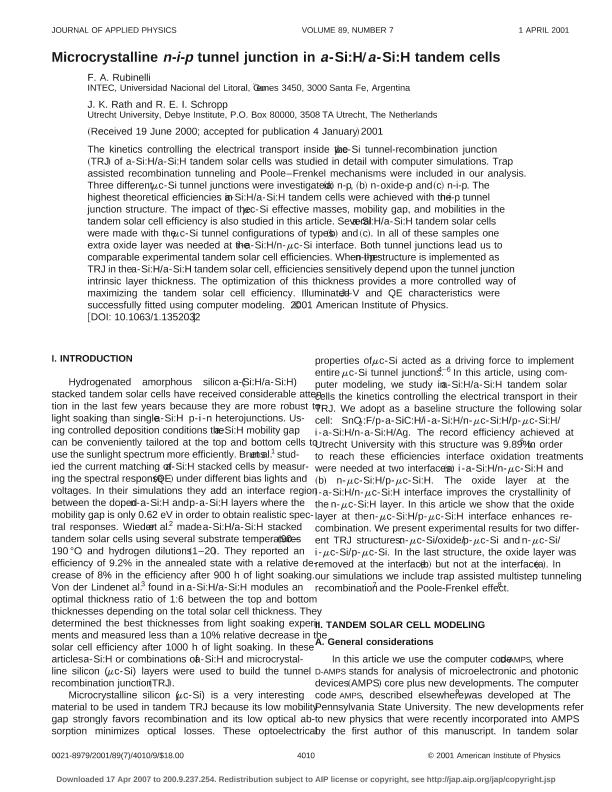Artículo
n-i-p Microcrystalline Tunnel Junction in a-Si:H/a-Si:H Tandem Cells
Fecha de publicación:
04/2001
Editorial:
American Institute of Physics
Revista:
Journal of Applied Physics
ISSN:
0021-8979
Idioma:
Inglés
Tipo de recurso:
Artículo publicado
Clasificación temática:
Resumen
The kinetics controlling the electrical transport inside the μc-Si tunnel-recombination junction (TRJ) of a-Si:H/a-Si:H tandem solar cells was studied in detail with computer simulations. Trap assisted recombination tunneling and Poole–Frenkel mechanisms were included in our analysis. Three different μc-Si tunnel junctions were investigated: (a) n-p, (b) n-oxide-p and (c) n-i-p. The highest theoretical efficiencies in a-Si:H/a-Si:H tandem cells were achieved with the n-i-p tunnel junction structure. The impact of the μc-Si effective masses, mobility gap, and mobilities in the tandem solar cell efficiency is also studied in this article. Several a-Si:H/a-Si:H tandem solar cells were made with the μc-Si tunnel configurations of types (b) and (c). In all of these samples one extra oxide layer was needed at the i-a-Si:H/n-μc-Si interface. Both tunnel junctions lead us to comparable experimental tandem solar cell efficiencies. When the n-i-p structure is implemented as TRJ in the a-Si:H/a-Si:H tandem solar cell, efficiencies sensitively depend upon the tunnel junction intrinsic layer thickness. The optimization of this thickness provides a more controlled way of maximizing the tandem solar cell efficiency. Illuminated J–V and QE characteristics were successfully fitted using computer modeling.
Palabras clave:
Tandem Solar Cells
,
Recombination Junctions
,
Amorphous Silicon
,
Modelling
Archivos asociados
Licencia
Identificadores
Colecciones
Articulos(INTEC)
Articulos de INST.DE DES.TECNOL.PARA LA IND.QUIMICA (I)
Articulos de INST.DE DES.TECNOL.PARA LA IND.QUIMICA (I)
Citación
Rubinelli, Francisco Alberto; Rath, J.K.; Schropp, R.E.I.; n-i-p Microcrystalline Tunnel Junction in a-Si:H/a-Si:H Tandem Cells; American Institute of Physics; Journal of Applied Physics; 89; 7; 4-2001; 4010-4020
Compartir
Altmétricas




